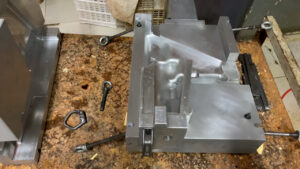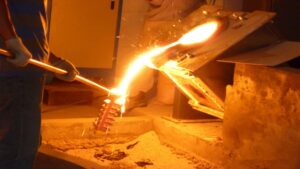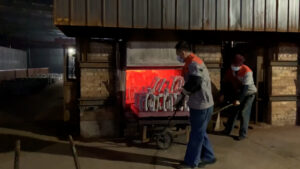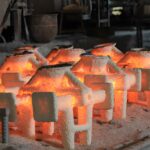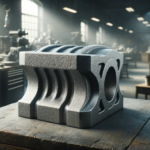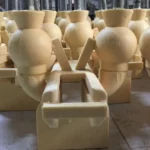Language:

Understanding the Precision of Lost Wax Casting Service: Process, Benefits, and Applications
Lost wax casting, also known as investment casting, is a time-honoured manufacturing process that allows for the creation of complex and detailed metal components with exceptional precision. Utilised for thousands of years, this technique has evolved to become an indispensable service in modern manufacturing across various industries. From aerospace and automotive to construction machineries and oil pipe lines, a professional lost wax casting service ensures that intricate designs can be realised with accuracy and efficiency.
In today’s competitive global market, the demand for high-quality lost wax casting services continues to grow, as manufacturers seek partners who can deliver customised solutions while maintaining tight tolerances and superior surface finishes. This article explores the intricacies of the lost wax casting process, highlighting its benefits, technological advancements, and the vast array of applications it supports.
Table of Contents
Understanding the Lost Wax Casting Process
The lost wax casting process, also known as investment casting, is a precise manufacturing technique that allows for the creation of highly detailed and complex metal parts. This method involves creating a wax model, or pattern, of the desired component, which is later replaced with molten metal to produce a high-precision final product. Here’s a step-by-step explanation of the lost wax casting process:
- Wax Pattern Creation: A wax pattern is made based on the specifications of the final component. The pattern can be created using injection moulding, manual carving, or, more recently, 3D printing. The wax pattern must accurately represent the final design, as it serves as the basis for the mould.
- Assembly of the Wax Tree: In cases where multiple parts are cast simultaneously, the individual wax patterns are assembled onto a central wax stem, called the “tree.” This assembly ensures efficient casting by allowing multiple parts to be produced in a single mould.
- Shell Building: The entire wax assembly is repeatedly dipped into a ceramic slurry and coated with fine sand to form a ceramic shell around the wax pattern. This process is repeated several times to build a thick, durable shell that can withstand the molten metal. Each layer must be dried thoroughly before the next is applied.
- Dewaxing: Once the ceramic shell is completed and cured, the wax inside is melted and drained out using a high-temperature autoclave or flash fire furnace. This step leaves behind a hollow ceramic mould with the shape of the final part.
- Metal Pouring: The ceramic mould is preheated to avoid thermal shock and filled with molten metal, usually by gravity pouring. The molten metal fills the hollow spaces left by the wax pattern, accurately replicating the original design.
- Cooling and Shell Removal: After pouring, the metal is allowed to cool and solidify within the ceramic shell. Once the metal has solidified, the ceramic mould is broken away using a pneumatic hammer, water blasting, or another suitable technique.
- Finishing and Inspection: The cast components are separated from the tree, and any remaining ceramic material is removed. The parts are then subjected to finishing processes such as grinding, machining, or surface treatment to achieve the desired specifications. Each part is inspected to ensure it meets quality standards.
The lost wax casting process offers remarkable precision and flexibility, making it suitable for creating intricate geometries and detailed surface features that would be challenging to achieve through other manufacturing methods. Its versatility and accuracy make it a highly sought-after service for various industries requiring reliable, high-quality metal components.

Key Features and Benefits of a Lost Wax Casting Service
A professional lost wax casting service offers a range of features and benefits that make it a vital component of modern manufacturing. Here are some key features and benefits that set this casting method apart:
- Precision and Accuracy: A well-executed lost wax casting service can reproduce intricate details and complex geometries with high precision. Taiyuan Simis Investment Casting Co., Ltd, for example, provides superior casting accuracy with tight dimensional tolerances, reducing the need for post-casting machining and minimising material wastage.
- Design Flexibility: The lost wax casting process allows for great design flexibility, enabling the production of components with thin walls, internal cavities, and undercuts. This versatility is advantageous in creating lightweight, structurally efficient designs. Taiyuan Simis Investment Casting Co., Ltd can produce custom castings tailored to specific customer requirements, providing the freedom to innovate.
- Exceptional Surface Finish: The ceramic shell used in lost wax casting provides a smooth surface finish, which often eliminates or reduces the need for further polishing or finishing. This quality is particularly beneficial for parts that require tight cosmetic or functional specifications.
- Material Versatility: A professional lost wax casting service is equipped to work with a broad spectrum of metals and alloys, including stainless steel, bronze, and aluminium. Taiyuan Simis Investment Casting Co., Ltd offers expertise in producing components from a variety of materials, ensuring that the final products meet the necessary performance and quality standards.
- Production Scalability: Whether a project requires a low-volume prototype or high-volume production, lost wax casting is scalable to accommodate different production needs. Taiyuan Simis Investment Casting Co., Ltd has the production capacity to handle both small and large-scale orders efficiently, making the service adaptable to diverse industrial demands.
- Cost-Effectiveness: Although the initial mould creation can be time-consuming, the high accuracy and repeatability of a lost wax casting service result in significant cost savings over time. The process enables near-net-shape casting, reducing material waste and eliminating the need for extensive machining.
- Customised Solutions: Tailoring the casting process to specific applications ensures that the finished products match customers’ unique requirements. Taiyuan Simis Investment Casting Co., Ltd offers comprehensive design assistance and technical support, enabling clients to refine their designs for optimal casting performance.
A reliable lost wax casting service can deliver remarkable value across a range of industries by providing precision, flexibility, and efficiency. Taiyuan Simis Investment Casting Co., Ltd stands out as a leader in this field, leveraging advanced techniques and state-of-the-art equipment to produce high-quality castings that meet the exacting standards of global customers.

Materials Commonly Used in Lost Wax Casting
A diverse selection of materials is utilised in a professional lost wax casting service, providing the flexibility to produce components tailored to specific applications. Here are some of the common metals and alloys used in the process:
- Stainless Steel: Known for its exceptional corrosion resistance, strength, and durability, stainless steel is a popular choice for components in the aerospace, medical, and food processing industries. A lost wax casting service can produce high-precision stainless steel parts that require minimal finishing due to the smooth surface finish provided by the process.
- Carbon Steel: Offering excellent mechanical properties and cost-effectiveness, carbon steel is frequently used in the production of machinery parts, automotive components, and structural equipment. Taiyuan Simis Investment Casting Co., Ltd leverages its expertise to deliver quality carbon steel castings with precise geometries and consistent quality.
- Aluminium: Aluminium is lightweight yet strong, making it ideal for applications that require reduced weight without compromising strength. Lost wax casting services can create aluminium parts with complex geometries and thin walls, which are crucial in the automotive, aerospace, and electronics industries.
- Bronze and Brass: Bronze and brass alloys are valued for their high corrosion resistance, electrical conductivity, and machinability. A lost wax casting service often uses these alloys for architectural, marine, and electrical components due to their superior casting properties and aesthetic appeal.
- Superalloys: Specialised superalloys, including those based on nickel or cobalt, are used in high-temperature and high-stress applications. They are critical in the production of turbine blades, aerospace components, and petrochemical equipment, where strength and resistance to heat and oxidation are essential. A lost wax casting service can craft superalloy components that withstand extreme environments while maintaining performance.
- Tool Steels: Known for their hardness and abrasion resistance, tool steels are used in the manufacturing of cutting tools, moulds, and die components. A lost wax casting service enables the production of intricate tool steel parts with high wear resistance, providing long-term durability in demanding environments.

By offering a broad selection of materials, a lost wax casting service can cater to the unique demands of various industries. Taiyuan Simis Investment Casting Co., Ltd provides expert guidance in material selection, ensuring that clients receive castings made from metals and alloys best suited to their specific performance requirements.
Industries and Applications
A high-quality lost wax casting service caters to a diverse range of industries due to the flexibility, precision, and cost-effectiveness of the process. Here are some of the key industries and the components they produce using lost wax casting:
- Aerospace: The aerospace industry relies heavily on a professional lost wax casting service to create turbine blades, engine components, and fuel system parts that must withstand high temperatures and mechanical stress. The precision of lost wax casting ensures that each part meets stringent performance and safety standards.
- Automotive: Gears, engine components, and exhaust systems are just a few examples of automotive parts produced using the lost wax casting process. The ability to create lightweight, strong components is crucial for reducing fuel consumption and emissions while maintaining the structural integrity of vehicles.
- Medical Devices: Precision is paramount in the medical field, which makes lost wax casting the ideal method for producing orthopaedic implants, dental tools, and surgical instruments. High-grade stainless steel and titanium alloys are often used due to their biocompatibility and corrosion resistance.
- Art and Sculpture: Artists and sculptors frequently utilise lost wax casting to create intricate bronze statues and other ornamental pieces. A lost wax casting service offers unparalleled detail and creativity for such works, with patterns replicating the most delicate and complex designs.
- Oil and Gas: In this industry, pump parts, drilling equipment, and valve components benefit from the strength, corrosion resistance, and high precision of investment castings. The ability of a lost wax casting service to produce reliable parts that can withstand harsh conditions is essential in these demanding environments.
- Defence: Military and defence applications often require lightweight yet durable components for equipment, weapons systems, and armoured vehicles. Lost wax casting allows for the production of these parts with high accuracy, ensuring the reliability and safety of critical systems.
- Agriculture Machinery: Agricultural machinery requires durable parts, such as cutting blades, gear housings, and engine components, that can endure prolonged exposure to harsh environmental conditions. A lost wax casting service provides custom components that deliver optimal performance and longevity in the field.
- Electronics: In the electronics industry, precision components are crucial for sensitive devices. Lost wax casting is used to create intricate housings, connectors, and cooling systems that maintain tight dimensional tolerances and offer effective thermal management.
These industries and applications highlight the broad applicability of a lost wax casting service across various sectors. By delivering customised, high-quality components with outstanding accuracy and consistency, lost wax casting continues to be a preferred choice for manufacturers worldwide.

China’s Advantage for Lost Wax Casting Service
China has become a dominant player in the global manufacturing industry, with its lost wax casting service recognised for delivering high-quality, cost-effective products. The following are some of the key advantages that give China an edge in providing lost wax casting services:
- Cost-Effectiveness: One of China’s primary advantages is the relatively low labour cost compared to other manufacturing hubs. This, combined with efficient production methods, means that a lost wax casting service in China can deliver complex castings at competitive prices. Taiyuan Simis Investment Casting Co., Ltd offers exceptional value due to its advanced technology, streamlined processes, and skilled workforce, enabling it to deliver quality castings while keeping costs down.
- High Efficiency: Chinese foundries are known for their impressive production speed, enabling them to handle large orders promptly without compromising quality. Taiyuan Simis Investment Casting Co., Ltd leverages state-of-the-art facilities and efficient supply chains to ensure high productivity, ensuring that customers receive their orders on time, even with tight deadlines.
- Advanced Technology: Foundries in China have heavily invested in modern equipment, automation, and quality control systems to enhance precision and productivity. The use of automated wax injection machines, ceramic shell-making systems, and X-ray inspection technologies ensures that each lost wax casting service meets international quality standards. Taiyuan Simis Investment Casting Co., Ltd utilises this advanced technology to guarantee dimensional accuracy and consistency in every casting.
- Material Sourcing and Expertise: China has a well-established supply chain network, giving foundries access to a broad range of high-quality metals and alloys. This access allows Chinese foundries to provide a lost wax casting service that can cater to various industries requiring specialised materials, such as aerospace or medical. Taiyuan Simis Investment Casting Co., Ltd has expertise in sourcing and working with diverse materials, ensuring that each customer’s specific requirements are met.
- Customisation Capabilities: Chinese foundries have developed comprehensive customisation capabilities, allowing them to offer a fully tailored lost wax casting service. Whether for intricate patterns or large-scale production, Taiyuan Simis Investment Casting Co., Ltd provides technical guidance and engineering support to optimise designs and deliver parts that meet unique specifications.
- Quality Control: Despite the high production speed and lower labour costs, Chinese foundries have established rigorous quality control processes to ensure that each casting meets strict standards. Taiyuan Simis Investment Casting Co., Ltd is ISO-certified and adheres to stringent quality assurance protocols, providing confidence that each casting will perform reliably.
Overall, China’s lost wax casting service offers a combination of affordability, efficiency, and precision that is difficult to match elsewhere. By choosing partners like Taiyuan Simis Investment Casting Co., Ltd, clients benefit from a comprehensive casting solution tailored to their specific industry requirements, backed by the latest technology and strict quality standards.
